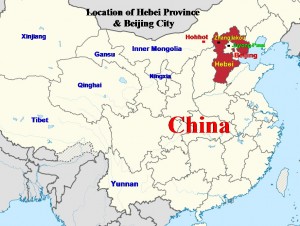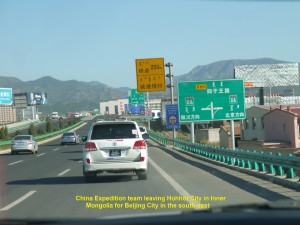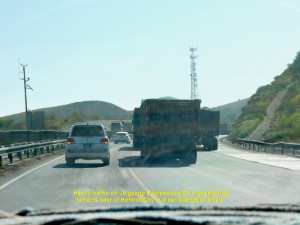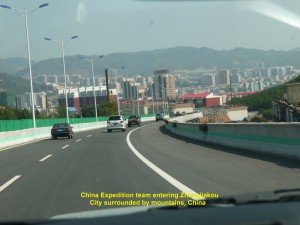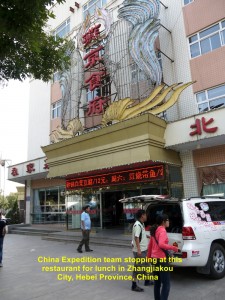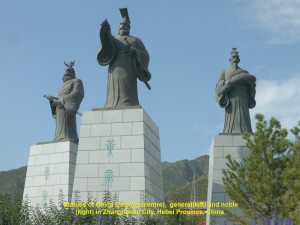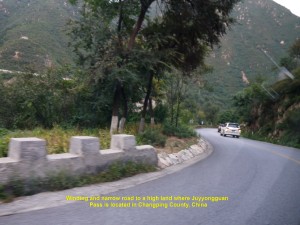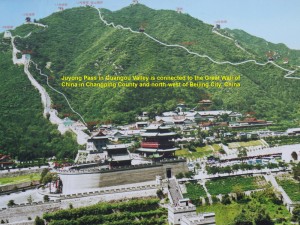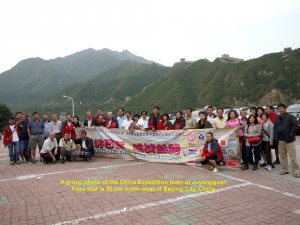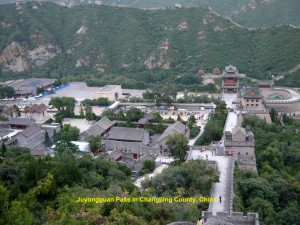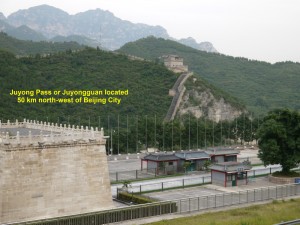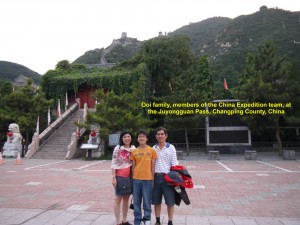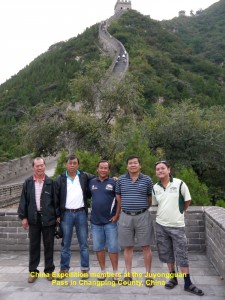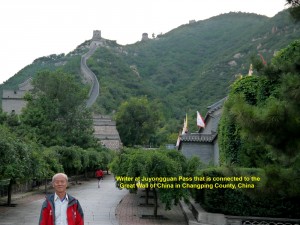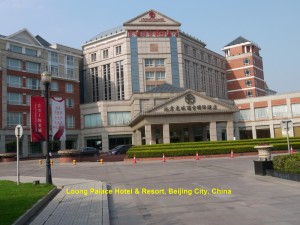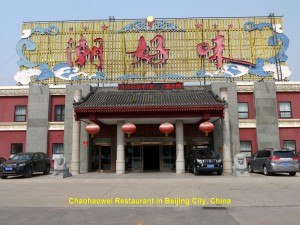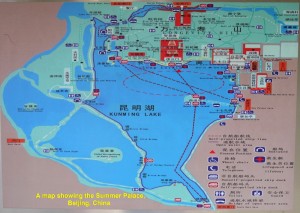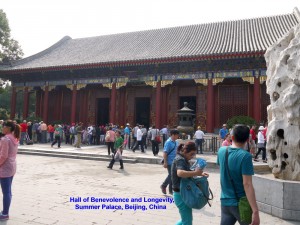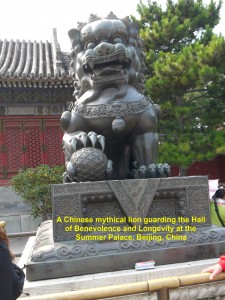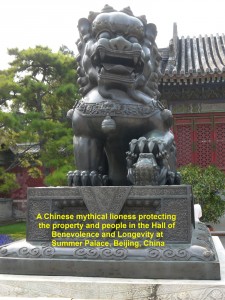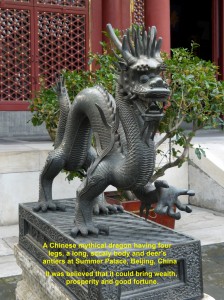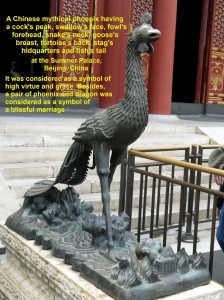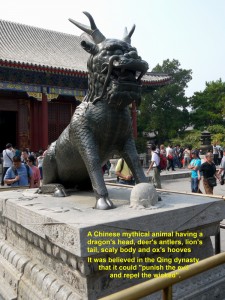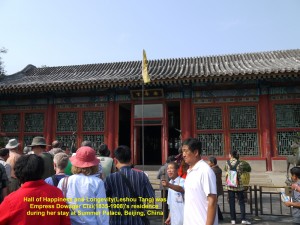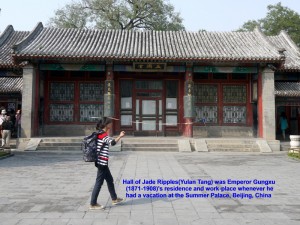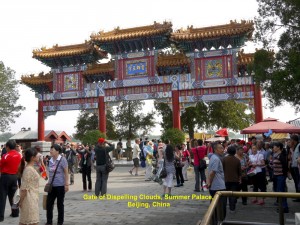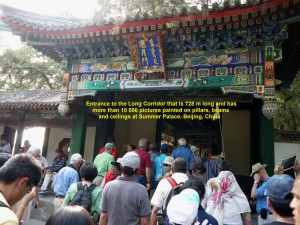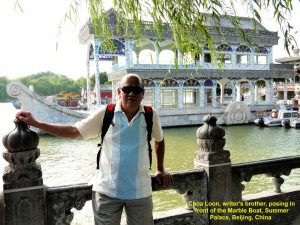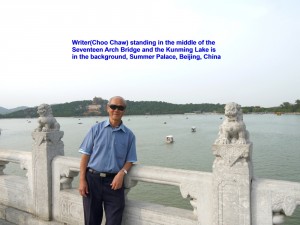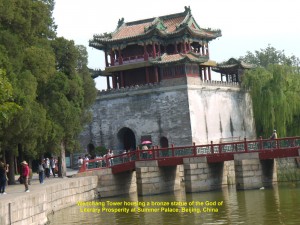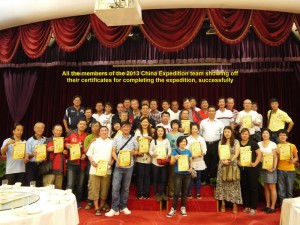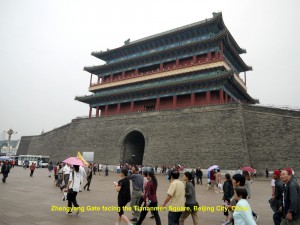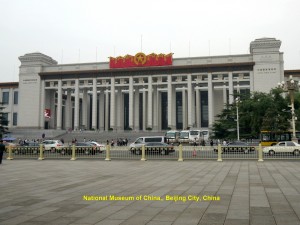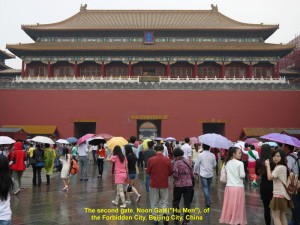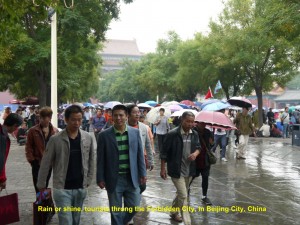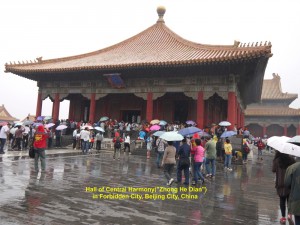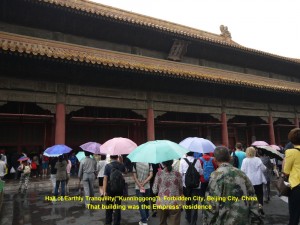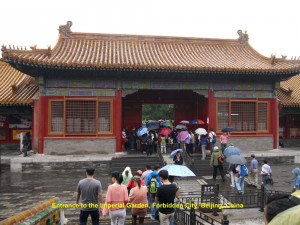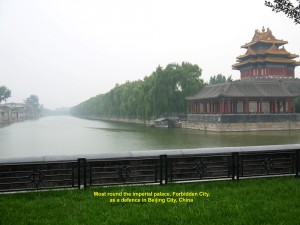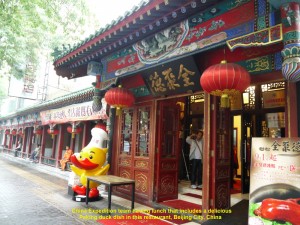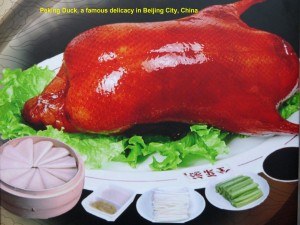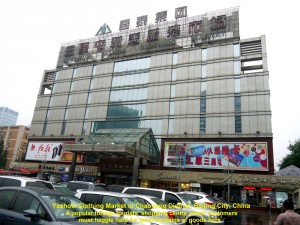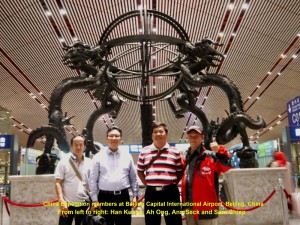Journal of My 2013 China Expedition Part IX (Beijing)
Journal of My 2013 China Expedition Part IX (Beijing)
Beijing Journey
Day 32 (Sunday, 15.9.2013)
Hohhot to Beijing Distance: 536 km
At 8.10 a.m. sharp we left Hohhot City in Inner Mongolia and travelled south-east to Beijing, the capital of China. It would be a long journey as the distance between them was 536 km.
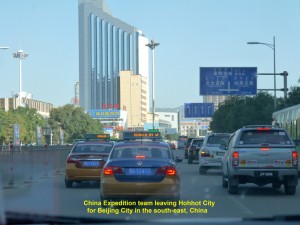
China Expedition team leaving Hohhot City in Inner Mongolia for Beijing City in the south-east, China
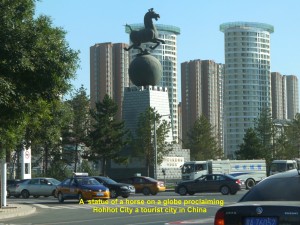
An important structure with a statue of a horse on a globe atop at a crossroads in Hohhot City proclaiming the city a tourist city in China
We were travelling on a good expressway, Jingzang Expressway(G6). Many heavy vehicles were using the road. For the first few hours we were crossing hilly terrains. Later we were travelling in a valley where Xiyang and Yanghe rivers flowed.
At 1.50 p.m. we entered Hebei Province and exited a Zhangjiakou toll gate from the Jingzang Expressway. A few minutes after leaving the toll gate and moving towards Zhangjiakou City, we sighted a long wall on the ridges of mountains in the distance. It was part of the Great Wall of China that protected Zhangjiakou City and Beijing City in the south from foreign invasions in the olden days. Ten minutes later at 2 p.m., we entered Zhangjiakou City and had lunch at a restaurant.
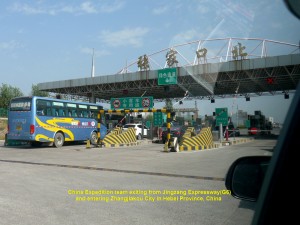
China Expedition team exiting a Zhangjiakou toll gate from Jingzang Expressway G6 to Zhangjiakou City in Hebei Province, China
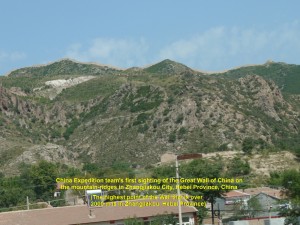
Part of the Great Wall of China on the mountain-ridges outside Zhangjiakou City, Hebei Province, China
Located 340 km east of Hohhot City, Zhangjiakou City has a population of about 4 millions. It is in a valley where a river, Tongqiao, flows through it and meets a large river, Yanghe, in the south. It is surrounded by mountains on which a part of the Great Wall of China was built in the ancient times to defend the city and Beijing in the south.
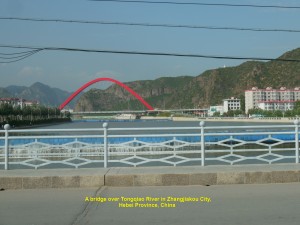
China Expedition team crossing a bridge over Tongqiao River in Zhangjiakou City and going back to Jingzang Expressway to Beijing City, China
After lunch at 3 p.m. we left Zhangjiakou City and resumed our journey to Beijing. We crossed a bridge over Tongqiao River in the city, passed three statues of a China emperor, noble and general, and went back to Jingzang Expressway G6. We headed south-east to a mountainous area which was 110 km away. At 4.50 p.m. we exited a Donghuayuan toll gate and travelled on a country road which later became narrow and winding in the mountainous area.
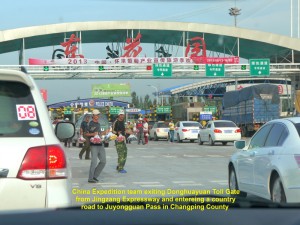
China Expedition team exiting a Donghuayuan toll gate and entered a country road to the Juyong Pass in Changping County
An hour later at 5.50 p.m., we arrived at a tourist spot, Juyongguan or Juyong Pass which was on the UNESCO World Heritage list in 1987. Located in the Guangou Valley in the Jundu Mountains and 50 km north of Beijing City, Juyong Pass was an important fort to many dynasties in the ancient times. It controlled the route in the valley from the north to Beijing in the south in the olden days. It is connected to a 4 km long wall that snakes its way to the mountain ridges on both sides of the valley. This wall then joins the Great Wall of China which protected the ancient rulers in the south.
When we arrived at Juyong Pass at 5.50 p.m., the place was already closed and deserted. But our China guides, Siao Gu and Siao Jun, appealed to a caretaker to allow us to tour that famous place as we had come from distant countries, Malaysia and Singapore. We were glad when the kind person allowed us to enter the historical area.
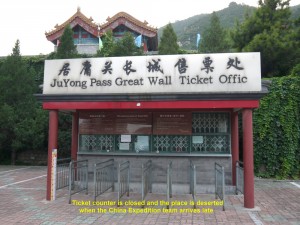
China Expedition team arriving at the Juyong Pass at 5.50 p.m. and found this ticket-counter closed.
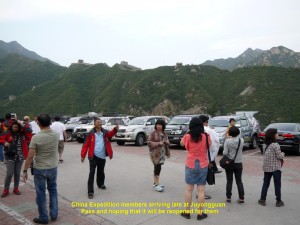
China Expedition team arriving late at Juyong Pass and finding it closed. They are hoping for it to be reopened.
We spent an hour touring the place. Looking around us, we were awe-stricken to see the awesome Great Wall which snakes its way up and down the ridges of the mountains and the Julong Pass(fort) in the valley that controlled the north-south route in ancient times.
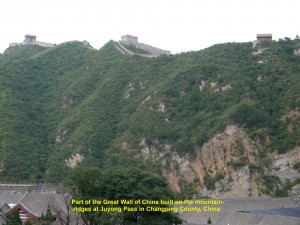
The Great Wall of China snakes its way on the mountain-ridges in the Jurong Pass area that is north-west of Beijing City, China
Some of us climbed up the steps on a wall that was on a steep slope of a mountain. When we reached the first watch-tower we stopped and saw a breathtaking view of the rest of the wall on the mountains in the distance and the Juyong Pass down in the Guangou Valley.
Owing to time constraint, we did not go up any further. So, we went down and back to our cars. At about 7 p.m. we left that historical place and continued to travel south-east to Beijing City. Over half an hour later, we arrived at the city. The traffic in the city was heavy and slow moving.
Finally, we arrived at a hotel, Loong Palace Hotel and Resort where we checked in and had dinner in its restaurant.
(In 2006 I visited Beijing City and wrote about it in these websites: Beijing, Tianjin and Chengde Travel(Part I) and Beijing, Tianjin and Chengde Travel(Part II))
Day 33(Monday, 16.9.2013)
Summer Palace Visit, Beijing City
At 9.30 in the morning, 15 members of the China Expedition drove their cars 114 km south-east to the Tianjin seaport where a ship would carry their vehicles back to Malaysia.
At 12.30 p.m. the remaining members including myself went to a restaurant, Chaohaowei Restaurant, in Beijing City to have lunch. In that restaurant I was attracted to a large, colourful and attractive mural showing many people from diverse ethnic groups living in China.
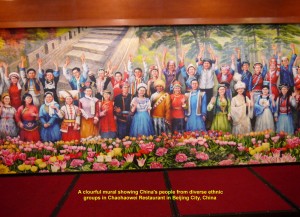
A beautiful mural showing China’s people of diverse ethnic groups in Chaohaowei Restaurant, Beijing City
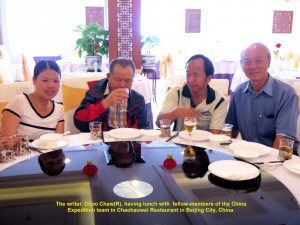
The writer(Choo Chaw) on the right having lunch with fellow-members in Chaohaowei Restaurant, Beijing City
After lunch, we went straight to a well-known ancient imperial garden, Summer Palace, located 15 km north-west of the city-centre. It was declared in 1998 a World Cultural Heritage site by the UNESCO. The garden is about 291 hectares, but three-quarters of it is lake that known as Kunming Lake.
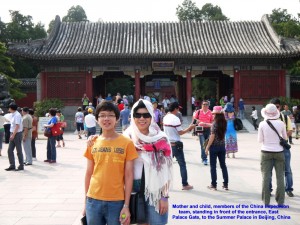
Mother and child, members of the China Expedition team, standing in front of the Summer Palace entrance, Beijing, China
On arrival at the Summer Palace at 2 p.m., we were glad that it was sunny and the air was clear. Then we entered the Palace through an entrance known as East Palace Gate. The first ancient building we saw was known as Hall of Benevolence and Longevity. It was used by Empress Dowager Cixi(1835-1908) and Emperor Guangxu(1871-1908) for holding court and administering state affairs.
In its courtyard, there were five large Chinese legendary or mythical creatures. They were lion, lioness, dragon, phoenix and “kylin”. In the olden days, the Chinese considered them as a symbol of virtue and believed that they had power of protecting people against evil, creating peace and harmony and bringing good fortunes to them.
Then we walked further in and saw two important old buildings. One known as Hall of Happiness & Longevity which was Empress Dowager Cixi’s residence and the other Hall of the Jade Ripples that was Emperor Guangxu’s residence. Both of them stayed there during hot summers.
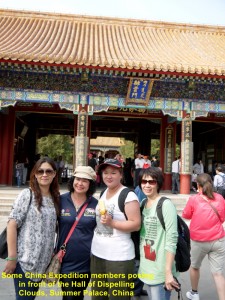
Fellow-members of the China Expedition team standing in front of the Hall of Dispelling Clouds, Summer Palace, Beijing
Later, we walked through the Hall of Dispelling clouds and into an open space by the Lake Kunming where a beautiful, tall archway known as Gate of Dispelling Clouds stood. We walked through it and then entered a long covered corridor. It was 728 metres long and had over 10 000 small Chinese paintings on its pillars, beams and ceilings. When we came out of the corridor, we saw a large stone boat, Marble Boat, which was 36 metres long in the lake.
At 3.20 p.m. we took a boat from a jetty near the Marble Boat, crossed the Kunming Lake and reached a tiny island, South Lake Island, in less than 10 minutes. While crossing the lake, we saw a prominent pagoda-like building, Hall of Buddhist Incense, on a slope of the Longevity Hill.
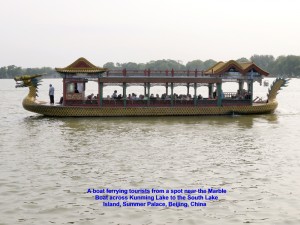
A boat ferrying tourists across the Kunming Lake to South Lake Island in less than 10 minutes, Summer Palace, Beijing
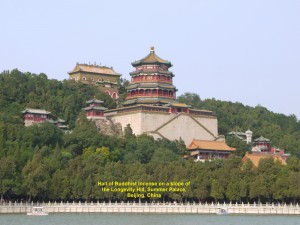
A prominent pagoda-like building known as Hall of Buddhist Incense on a slope of Longevity Hill, Summer Palace, Beijing
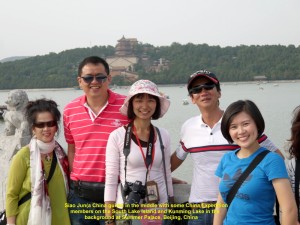
Some fellow-members of the Expedition on the South Lake Island at Kunming Lake, Summer Palace, Beijing
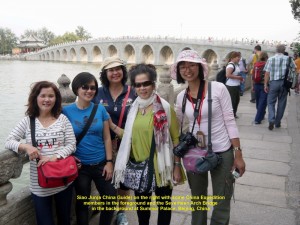
Fellow-members with the China guide, Siao Jun(R), on South Lake Island at Kunming Lake, Summer Palace, Beijing
As there was nothing much to see on that small island, we walked to a long, wide bridge, Seventeen Arch Bridge. While I was crossing it, I stopped in the middle and saw a breathtaking view of the lake and its surroundings.
After crossing the bridge, I came across a life-size bronze ox which was facing the Kunming Lake. It was made by Emperor Qianlong(1711-1799) in 1755 as he believed that it could prevent flooding in the area. As I walked further down I came across a three-storey ancient building, Wenchang Tower, that housed the God of Literary Prosperity.
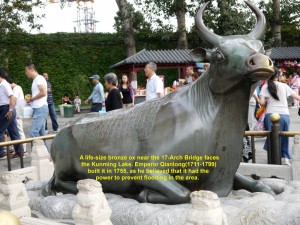
A life-size bronze ox near the 17-Arch Bridge was made by Emperor Qianlong believing that it could prevent flood in the area
At 4 p.m. we left that large, beautiful, pristine, classical imperial Summer Palace and went downtown to a shopping mall where we had western food for tea.
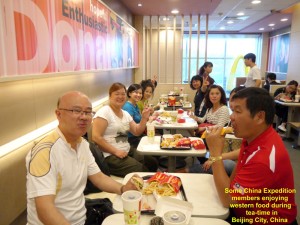
Some fellow-members of the Expedition having western food for tea in a shopping mall in Beijing City, China
At 8 p.m. all the Expedition members had dinner at a restaurant in Mercure Wanshang Beijing Hotel in the city. During the dinner, our group leader, Kong Kun Lin, congratulated all the members for having, successfully, completed the journey from Malaysia to Thailand, Laos, Yunnan, Tibet, Qinghai, Xinjiang, Gansu, Inner Mongolia and finally, to Beijing. Besides, he thanked all the China guides from Yunnan Province for making our Expedition a great success.
For all of us, a long journey that took us 33 days to complete was an enjoyable and unforgettable one. Then we all received a certificate proving our participation in the successful Expedition.
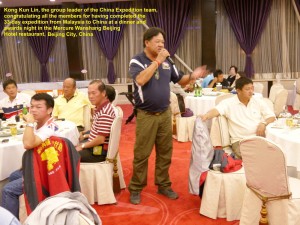
The group leader of the 2013 China Expedition, Kong Kun Li, making a congratulatory and acknowledgement speech at a dinner in Beijing City
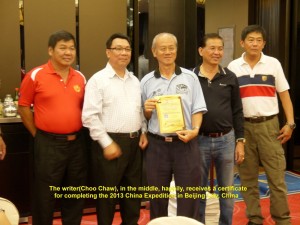
The writer, Choo Chaw, showing off a certificate he receives certifying his participation in the successful Expedition
Day 34(Tuesday, 17.9.2013)
Tiananmen & Forbidden City Visit in Beijing City
At 9 in the morning we left Loong Palace Hotel and went to a well-known large imperial palace in the world. Located in the centre of Beijing City, it is popularly known as Forbidden City.
Built in the 1406-1420 period, it became the residence of 24 emperors of the Ming and Qing Dynasties for about 500 years. The last emperor, Puyi, vacated the palace when his Qing Dynasty was overthrown by the 1911 Revolution. The palace was known as Forbidden City as no commoners were allowed to enter the heavily-guarded place during the emperors’ reigns.
In 1925 the palace was established as the Palace Museum. Then in 1987 it was declared by UNESCO as a World Heritage site.
At about 10 a.m. we arrived in a large open rectangular space, Tiananmen Square. Although it was drizzling, we could see many tourists in the Square walking towards the Forbidden City. Facing the Square stood a large gate, Zhengyang Gate.
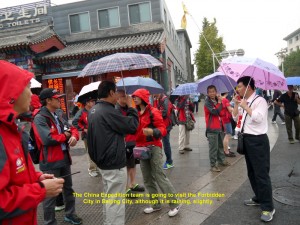
The China Expedition team is going to visit Tiananmen Square and the Forbidden City, although it is drizzling.
As we were crossing the Square, we could see the Chairman Mao Zedong Mausoleum where the embalmed body of the Chairman was placed in a crystal coffin in 1976. People from far and wide queued up to enter the mausoleum.to see the body.
In front of the mausoleum was a clay sculpture of the socialist construction workers of the Chinese Communist Revolution and in the Square centre a 38 metre-high monument, Monument to the People’s Heroes. It was built in the 1950’s in memory of the martyrs of revolutionary struggle during the 19th. and 20th. Centuries.
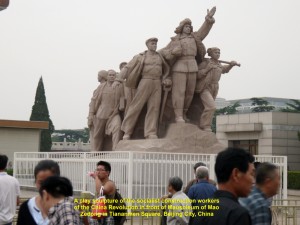
A clay sculpture of the socialist construction workers of the Chinese Communist Revolution in front of Mao Zedong Mausoleum in Tiananmen Square, Beijing City
Further away on our left was a large building opened in 1959, Great Hall of the People, which was a meeting place of the National People’s Congress(the Chinese Parliament). Another large building could be seen in the distance on our right and it was National Museum of China. Established in 2003, it showcased the arts and history of China.
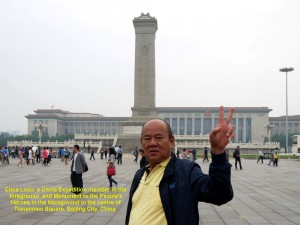
Behind Choa Loon, an Expedition member, is a tall column known as the Monument to the People’s Heroes and the large building the Great Hall of the People in the distance
After crossing the Tiananmen Square, we came to a large, red wall with five gates, a large portrait of Chairman Mao Zedong hanging in the middle and Chinese characters, “Zhonghua Renmin Gonghegou Wansui” and “Shijie Renmin Tuanjie Wansui”, that mean “Long Live the People’s Republic of China” and “Long Live the Great Unity of the World’s Peoples”. Built in 1415 during the Ming Dynasty, the wall was known as Tiananmen Gate(Heavenly Peace Gate). It was the main entrance to the Imperial Palace or Forbidden City.
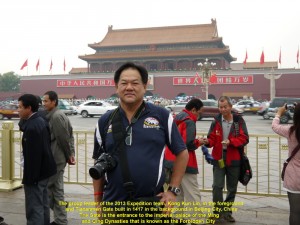
Behind Kong Kun Lin, the Expedition group leader, is the Tiananmen Gate which is the first entrance to the Forbidden City, Beijing City, China
Entering the Gate, we came across another red gate known as Noon Gate(“Hu Men”). Walking through that gate we came to another red gate known as Gate of Supreme Harmony(“Tai He Gate”). Then we went through that gate and saw a large important ancient building where grand imperial ceremonies were, usually, held. It was known as Hall of Supreme Harmony(“Tai He Dian”).
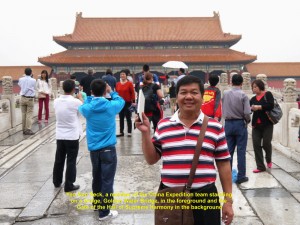
Behind Yeo Ann Seck, an Expedition member, is the Gate of Supreme Harmony(“Tai He Men”), the third gate of the Forbidden City, Beijing City, China
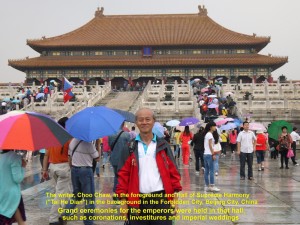
Behind the writer, Choo Chaw, is the largest building, Hall of Supreme Harmony, in the Forbidden City. Grand imperial ceremonies were often held in the hall.
There were two smaller buildings behind the Hall. They were Hall of Central Harmony(“Zhong He Dian”) and Hall of Preserved Harmony(“Bao He Dian”) where rehearsing imperial ceremonies and the final part of the imperial exams were carried out.
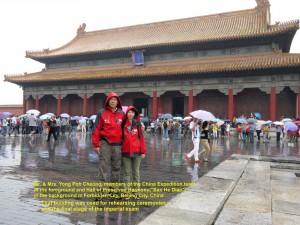
Behind Yong Poh Cheong and his wife is the Hall of Preserved Harmony(“Bao He Dian”). It was used for rehearsing ceremonies and the final stage of the imperial exams.
As we walked further inside, we passed through a gate, Gate of Hall of Heavenly Purity(“Qian Qing Gong Men”). It was an entrance to the emperor’s residence, Hall of Heavenly Purity(“Qian Qing Gong”) and empress’ residence, Hall of Earthly Tranquility(“Kun Ning Gong”). The door of the emperor’s residence was closed. When I looked into the living room through a glass-panel of the door I could see a throne and four Chinese characters above it: “Zheng Da Guang Ming” which means “Justice and Honour”.
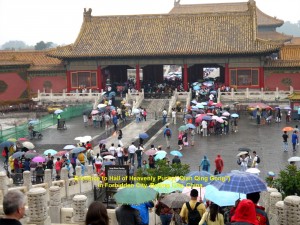
Gate of Hall of Heavenly Purity(“Qian Qing Gong Men”) is the entrance to the Emperor’s and Empress’ residences in the Forbidden City, Beijing City, China
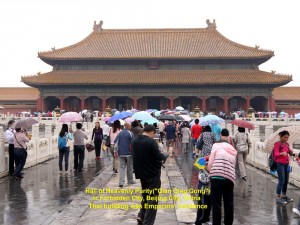
Hall of Heavenly Purity(“Qian Qing Gong”) was the Emperor’s residence in the Forbidden City, Beijing City, China
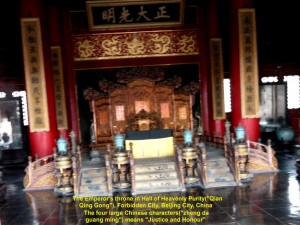
The Emperor’s throne in his residence, Hall of Heavenly Purity(“Qian Qing Gong”), in the Forbidden City, Beijing City, China
Then we entered another gate that led us into the imperial garden where there were two interesting trees that interlocked each other. A notice-board in between them said that the last Emperor of China, Puyi, and his Empress, Wanrong, vowed in front of the trees that they would be together forever, immediately, after their wedding.

The last emperor of China, Puyi, and his empress, Wanrong, vowed in front of those two interlocking trees that they would be together forever in the Imperial Garden in the Forbidden City.
Finally, we came out of the Forbidden City through the back gate with five Chinese characters that said, “Ancient Palace Museum”. Outside the palace we saw a wide moat that surrounded it for defence.
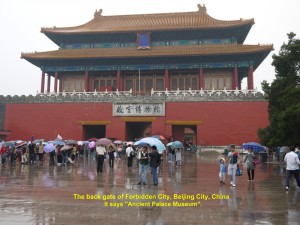
The back gate of the palace, Forbidden City. The five Chinese characters says “Ancient Palace Museum”.
At 12 noon we left the Forbidden City and went to a restaurant for lunch. We were served a great delicacy, roasted duck popularly known as Peking Duck. A few roasted ducks were sliced in thin pieces with crispy skin by a chef in front of us.
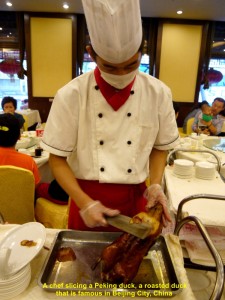
A chef slicing Peking duck for the China Expedition team’s lunch in a restaurant in Beijing City, China
At 3 p.m. we left the restaurant and went to a shopping centre, Yashow Clothing Market, in Chaoyong District, Beijing. It is a popular tourists’ shopping place where footwear, clothes, luggage, electronic gadgets, etc. are sold there. The initial asking prices by the salespersons there are normally very high. Take for example, my case. I wanted to buy three ordinary T-shirts from a salesperson at one of the clothing stalls. After I had chosen three pieces, the man used a calculator and showed me an astronomical figure, 450(RMB), for the shirts! Of course, he expected me to bargain. So, I told him that I was willing to pay RMB90 for the shirts. As he refused to accept the price, I walked away. Then he shouted a price of RMB100. Thinking that it was about 22% of his first asking price and reasonable, I walked back and paid him the money for the shirts. So, if you go to such a shopping place, do not be afraid to haggle over the prices to as low as 20-30% of a seller’s initial asking price of a product you want.
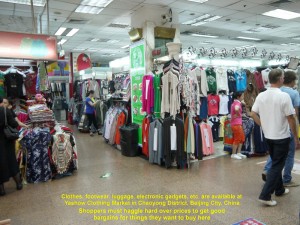
Yashow Clothing Market, a shopping centre where all kinds of daily needs are available, like footwear, clothes, electronic gadgets, etc.
After our dinner at a restaurant near Yashow Clothing Market, we left for Beijing Capital International Airport. On arrival at the airport, we checked in at a departure counter. Then we thanked and bade farewell to our two capable guides who were present, Siao Gu and Siao Jun, from Yunnan Province. They had assisted us a lot in our unforgettable China Expedition.
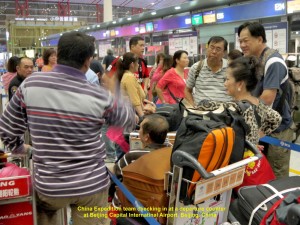
China Expedition team checking in at a departure counter at Beijing Capital International Airport, Beijing, China
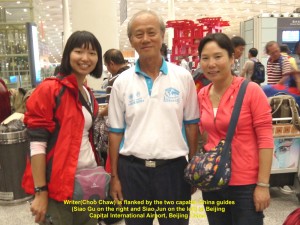
The writer, Choo Chaw, is flanked by two capable China guides, Siao Gu(R) and Siao Jun(L), who have assisted all the time in the China Expedition
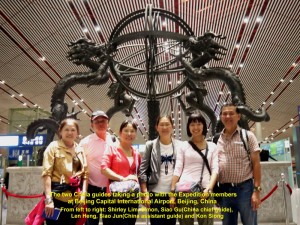
The two China guides taking a photo with some Expedition members at Beijing Capital International Airport, Beijing, China
At 1.40 a.m. our plane took off at Beijing Capital International Airport and headed south-west for Kuala Lumpur International Airport(KLIA) in Malaysia. Six hours later, we finally landed, safely, at the airport in our homeland that we had missed for over 30 days.
We are glad to have participated in the expedition and brought back lots of memorable experiences and rich knowledge of China’s history and diverse physical landscapes, climates, cultures, races, religions, economic activities, etc. Besides, we have enjoyed our comradeship during the expedition.
Acknowledgement:
I would like to thank Kluang Hakka Association and Johor Bahru Yang Association for, jointly, organising the China Expedition and allowing me to join it.
Thanks to our group leader, Kong Kun Lin, and all the China guides like Siao Gu, Siao Jun, Siao Wang, Siao Mok and Siao Wang to name a few. Without them our expedition would not be possible.
Last but not least, I would like to thank Wong Yok Sang, an amazing person, for driving Tan Chee Eng and me in his car all the way from Malaysia to Beijing City, safely.
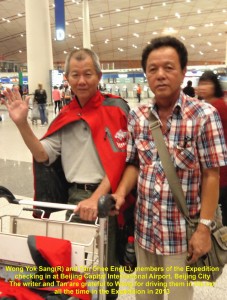
Wong Yok Sang(R) and Tan Chee Eng(L), members of the Expedition at Beijing Capital International Airport, Beijing, China
Written by Choo Chaw, Kluang, Johor, Malaysia
Journal of My 2013 China Expedition:

